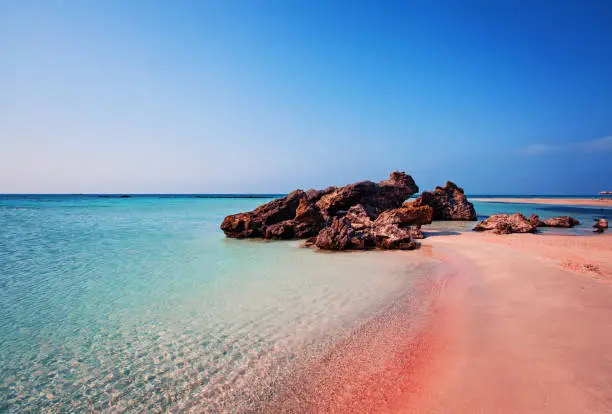
Have you ever imagined a beach with pink sand? It sounds like something from a fairy tale, right? Welcome to Elafonissi Beach, a magical spot that looks like it’s straight out of a dream.
Elafonissi Beach isn’t your average seaside destination. It’s a special place where nature has painted the sand in soft shades of pink. This unique beach is tucked away on the island of Crete in Greece. It’s a place that makes people’s eyes go wide with wonder as soon as they see it.
But what makes Elafonissi so amazing? Is it just the pink beach sand, or is there more to this beach than meets the eye? Let’s dive in and discover the secrets of this beautiful place that’s capturing the hearts of people from all around the world. Let’s explore beach life experience at create in Greece.
Where is Elafonissi Beach?
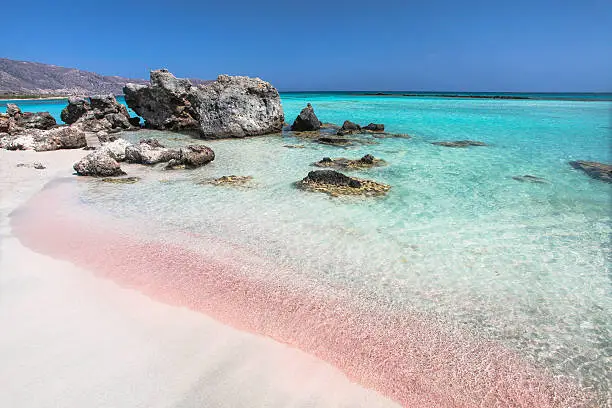
Elafonissi Beach is like a hidden treasure on the map. You’ll find it on Crete, which is the largest island in Greece. If you look at the bottom left corner of Crete, that’s where Elafonissi is hiding. It’s in the southwestern part of the island, in an area called Chania.
Imagine Crete as a big, oddly-shaped puzzle piece floating in the blue Mediterranean Sea. Now, picture yourself zooming in on the western edge of that puzzle piece. That’s where you’ll spot Elafonissi, a little slice of pink paradise waiting to be explored.
How to get there
Getting to Elafonissi is part of the adventure! If you’re already on Crete, you have a few options:
- By Car: This is probably the easiest way. From Chania, the nearest big city, it’s about a 75-kilometer (or 47-mile) drive. The trip takes around 1.5 to 2 hours. The road winds through mountains and along the coast, giving you amazing views along the way. Just remember to drive carefully on the curvy mountain roads!
- By Bus: If you don’t want to drive, you can hop on a public bus from Chania. The bus ride is longer, usually around 2.5 hours, but it’s a chance to sit back and enjoy the scenery without worrying about navigating.
- By Boat: During the summer, you might be able to catch a boat tour from some nearby towns. This option lets you see the beautiful coastline from the sea.
- Organized Tours: Many companies offer day trips to Elafonissi. These tours usually include transportation and sometimes a guide who can tell you all about the area.
If you’re not on Crete yet, you’ll need to get there first. You can fly into one of Crete’s airports (the closest one to Elafonissi is in Chania) or take a ferry from mainland Greece or other islands.
Remember, Elafonissi is in a pretty remote area. There aren’t any big towns nearby, so it’s a good idea to plan your trip carefully. But don’t worry – the journey is worth it when you finally see that pink sand!
The Pink Phenomenon: Why is the sand pink?
Now, let’s talk about the star of the show – that amazing pink beach sand! The color of Elafonissi’s sand is what makes it famous, but it’s not pink because someone poured paint on it. The pinkish color is all-natural, and the story behind it is pretty cool.
The pink shade comes from tiny pieces of seashells mixed in with the sand. Over many, many years, waves have crashed against the rocky shore, breaking down red and pink shells into tiny fragments. These little bits of shell get mixed in with the white sand, giving the beach its unique color.
The main type of shell responsible for this is from tiny sea creatures called foraminifera. These creatures have reddish shells, and when they die, their shells break down and mix with the sand. It’s like nature decided to sprinkle some color on the beach!
But here’s a fun fact: the sand isn’t always bright pink. Sometimes it looks more white with just a hint of pink. The color can change depending on many things like the time of day, the weather, and even how the waves are moving.
Best times to see the pink hue
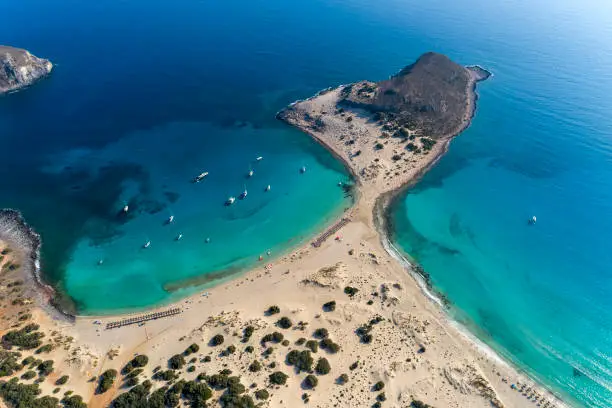
If you want to see Elafonissi Beach at its pinkest, here are some tips:
- Timing is key: The pink color often looks strongest in the late afternoon when the sun is lower in the sky. This is when the sunlight hits the sand at just the right angle to make the pink pop.
- After a storm: Sometimes, the pink is more visible after stormy weather. The waves bring up more shell fragments from the sea floor, making the color more intense.
- Wet sand: The pink often shows up better when the sand is wet. So, walking along the water’s edge or visiting on a day when there’s been a light rain might give you the best view of the pink sand.
- Seasonal changes: Some people say the pink is most visible in the spring and early summer. This might be because there are fewer people walking on the beach, so the sand is less disturbed.
- Look closely: Sometimes, you need to get up close to really see the pink. Don’t be afraid to crouch down and look carefully at the sand – you might be surprised by the colors you see!
Remember, the pink color of Elafonissi isn’t always super bright or obvious. It’s often a subtle, delicate shade that changes with the light. This natural beauty is part of what makes Elafonissi so special – it’s like a color-changing magic trick that nature puts on every day!
Also Read: Hiking in Bali Best 10 trails 2024 | Bali Hiking
Crystal Clear Waters: Shallow lagoons
One of the things that makes Elafonissi Beach extra special is its amazing water. When you first see it, you might think someone spilled a giant bottle of blue food coloring into the sea – that’s how bright and clear it is!
Elafonissi is famous for its shallow lagoons. A lagoon is like a small sea that’s partly separated from the larger body of water. At Elafonissi, these lagoons are incredibly shallow. In many places, the water is only knee-deep, even when you’ve walked quite far from the shore.
This shallow water has a few cool effects:
- It gets warm quickly: Because it’s so shallow, the water heats up fast in the sun. This makes it really nice for swimming, almost like a natural bathtub!
- It’s super clear: In shallow water, it’s easier to see the bottom. At Elafonissi, you can often see right through the water to the sand below, even when you’re swimming.
- It creates beautiful colors: The shallow water reflects the sky and the sand beneath, creating gorgeous shades of blue and turquoise. It’s like being inside a painting!
- It’s calm: The shallow lagoons are protected from big waves, so the water is usually very calm and gentle.
Perfect for families and non-swimmers
All these features make Elafonissi Beach a great place for all kinds of visitors, especially families with kids and people who aren’t strong swimmers.
For families:
- The shallow water means kids can play safely without going out of their depth.
- The soft sand is great for building sandcastles or playing beach games.
- The calm water means parents can relax a bit more, knowing big waves won’t knock their kids over.
For non-swimmers or beginners:
- You can enjoy being in the water without needing to swim in deep areas.
- The clear water lets you see the bottom, which can help people feel more comfortable.
- You can walk out quite far while still touching the ground, giving you a chance to get used to the water.
Even for experienced swimmers, the crystal-clear water of Elafonissi is a joy. It’s perfect for snorkeling, as you can easily see fish and other sea life in the shallow water. And on windy days, the larger waves beyond the lagoons can be fun for more adventurous swimmers.
Remember, though, that even in shallow water, it’s important to be careful. Always keep an eye on children, follow any safety guidelines, and be aware of your surroundings. The sea can sometimes be unpredictable, even in a peaceful place like Elafonissi.
Island Hopping on Foot: The sandbar to Elafonissi Island
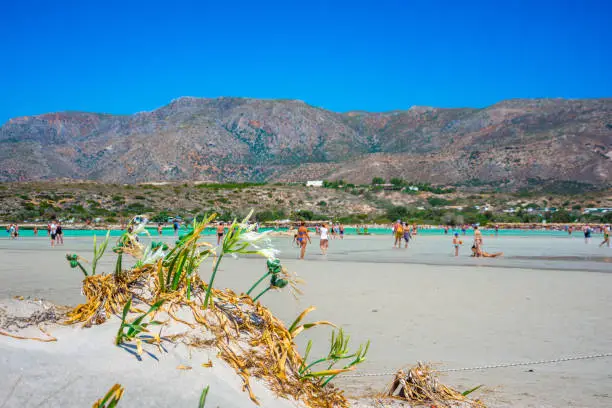
One of the coolest things about Elafonissi Beach is that you can actually walk to an island! This might sound impossible, but it’s true, thanks to a special feature called a sandbar.
A sandbar is a long stretch of sand that’s usually underwater but sometimes pops up above the surface. At Elafonissi, there’s a sandbar that connects the main beach to a small island, also called Elafonissi.
Here’s what makes this sandbar so special:
- It appears and disappears: Depending on the tide (the rising and falling of the sea), the sandbar might be visible or hidden underwater. It’s like a magic bridge that nature creates and erases every day!
- Walking on water: When the tide is low, you can walk across the sandbar to the island. It feels a bit like you’re walking on water, with the sea on both sides of you.
- Shallow crossing: Even when the sandbar is underwater, the water is usually only ankle to knee-deep, so you can still wade across easily.
- Changing landscape: The shape and size of the sandbar can change over time due to waves and currents. This means each visit to Elafonissi might give you a slightly different experience.
Walking across to Elafonissi Island is a must-do activity for most visitors. It’s not every day you get the chance to stroll to an island!
Unique flora and fauna
Once you reach Elafonissi Island, you’ll find it’s more than just an extension of the beach. This small island is home to some unique plants and animals that make it a protected nature area.
Flora (Plants):
- Sea daffodils: These beautiful white flowers bloom in late summer and early fall. They’re tough plants that can survive in the salty, sandy soil.
- Juniper trees: These small, hardy trees can withstand the strong winds that sometimes blow across the island.
- Sea lilies: Another pretty flower that thrives in this coastal environment.
Fauna (Animals):
- Loggerhead sea turtles: These endangered turtles sometimes nest on the beaches here. If you’re lucky, you might spot their tracks in the sand.
- Seabirds: The island is a haven for various types of seabirds. Keep your eyes open for seagulls, cormorants, and other coastal birds.
- Lizards: Small lizards often scurry around the rocks and plants on the island.
The island also has some interesting history. There’s a small church and a lighthouse, reminders that people have been visiting this little island for a long time.
When you’re exploring Elafonissi Island, remember that it’s a protected area. This means:
- Don’t pick any plants or flowers
- Don’t disturb any animals you see
- Stay on marked paths to avoid damaging the fragile ecosystem
- Take any trash with you when you leave
By respecting the island’s nature, we can help keep it beautiful for future visitors and protect the unique plants and animals that call it home.
Walking to Elafonissi Island is like a mini-adventure right in the middle of your beach day. It’s a chance to explore, see some unique nature, and experience the changing moods of the sea. Plus, it gives you a great story to tell when you get home – how many people can say they walked to an island?
Beyond the Beach: Nearby attractions
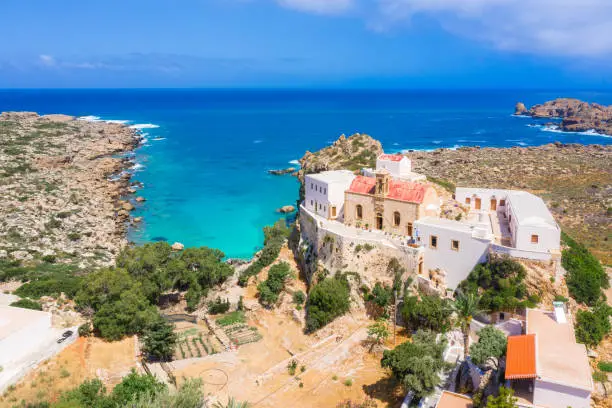
While Elafonissi Beach is amazing, there’s plenty more to see and do in the area. If you’re up for some exploring, here are some nearby attractions worth checking out:
- Chrysoskalitissa Monastery: About 5 kilometers from Elafonissi, this white monastery sits on top of a rock. It’s said to have a golden step – can you find it? The views from up there are fantastic!
- Kedrodasos Beach: Just a few kilometers east of Elafonissi, this beach is known for its cedar trees and is usually less crowded. It’s great for a quieter day out.
- Topolia Gorge: If you like hiking, this gorge offers beautiful views and a chance to see some of Crete’s inland scenery.
- Cave of Agia Sofia: Near the village of Topolia, this cave has a tiny church inside it. It’s a cool and mysterious place to visit.
- Elos Village: This small mountain village is known for its chestnut trees. In October, they have a chestnut festival!
- Paleochora: This charming town is a bit further away (about an hour’s drive) but offers a nice change of pace with its tavernas, shops, and beaches.
Remember, western Crete is full of beautiful landscapes, traditional villages, and historical sites. If you have time, it’s worth exploring beyond Elafonissi beach to get a fuller picture of this amazing part of the world.
Local cuisine to try
One of the best parts of visiting a new place is trying the local food, and the area around Elafonissi beach has some delicious options. Cretan cuisine is known for being healthy and tasty. Here are some local dishes and products you might want to try:
- Dakos: This is like a Cretan bruschetta. It’s a dried bread or barley rusk topped with chopped tomatoes, feta cheese, olive oil, and oregano.
- Kalitsounia: These are small cheese or herb pies, often served as a snack or appetizer.
- Grilled octopus: If you like seafood, this is a must-try. It’s often served with a drizzle of olive oil and lemon.
- Cretan cheeses: Try graviera (a hard cheese similar to gruyere) or mizithra (a soft, fresh cheese).
- Horta: These are wild greens that are boiled and served with olive oil and lemon. They’re super healthy!
- Souvlaki: While this is popular all over Greece, Cretan souvlaki often uses local meats like lamb or goat.
- Cretan olive oil: Crete is famous for its olive oil. Many tavernas will serve it with bread as soon as you sit down.
- Local wines: Crete has been making wine for thousands of years. Try some local varieties with your meal.
- Raki or tsikoudia: This is a strong grape-based spirit that locals often drink at the end of a meal. Just be careful – it’s very strong!
When you’re near Elafonissi beach, look for small tavernas in nearby villages. These often serve the most authentic local food. Don’t be afraid to ask the staff for recommendations – Cretans are usually happy to share their food culture with visitors.
Remember, meal times in Greece are often later than in some other countries. Lunch might be around 2 or 3 pm, and dinner often starts after 8 pm. But don’t worry – if you’re hungry earlier, you can usually find a place serving food.
Trying local food is a great way to understand more about the culture and people of the place you’re visiting. Plus, after a day of swimming and sunbathing at Elafonissi beach, you’re sure to have worked up an appetite!
Practical Tips for Visitors: Best time to visit
Choosing when to visit Elafonissi beach can make a big difference to your experience. Here’s a breakdown of what to expect in different seasons:
- Summer (June to August):
- This is the busiest time, with the warmest weather and most tourists.
- Daytime temperatures are usually between 28-35°C (82-95°F).
- The sea is warm and perfect for swimming.
- You’ll need to arrive early to get a good spot on the beach.
- Spring (April to May) and Fall (September to October):
- These are great times to visit if you want to avoid crowds.
- The weather is still warm, usually around 20-25°C (68-77°F).
- The sea might be a bit cooler but still nice for swimming.
- You might see more of the local flowers blooming.
- Winter (November to March):
- Elafonissi is very quiet in winter, and some facilities might be closed.
- It can be rainy and windy, with temperatures around 10-15°C (50-59°F).
- This isn’t a good time for beach activities, but it can be beautiful for walks and photography.
The best time to visit depends on what you’re looking for. If you love hot weather and don’t mind crowds, summer is great. If you prefer a quieter experience and don’t need super hot temperatures, spring or fall might be better.
What to bring at Elafonissi beach
To make the most of your day at Elafonissi beach, here’s a list of things you might want to bring:
- Sunscreen: The sun can be very strong, especially in summer. Bring high SPF sunscreen and reapply often.
- Hat and sunglasses: These will help protect you from the sun.
- Water shoes: The sand is soft, but there can be some rocky areas, especially if you’re exploring the island. Water shoes can protect your feet.
- Beach umbrella or tent: There are some umbrellas for rent, but bringing your own sun protection is a good idea, especially if you arrive late.
- Snorkeling gear: The clear water is perfect for spotting fish, so bring a mask and snorkel if you have them.
- Towels: Don’t forget to bring beach towels for drying off and lying on the sand.
- Picnic supplies: While there are some snack bars, bringing your own food and drinks can save money and time.
- Camera: You’ll want to capture the beautiful scenery, but remember to protect your camera from sand and water.
- Cash: Some small businesses in the area might not accept cards, so it’s good to have some cash on hand.
- Reusable water bottle: Stay hydrated and help reduce plastic waste by bringing a refillable bottle.
Facilities available
Elafonissi Beach has some basic facilities to make your visit more comfortable:
- Parking: There’s a large parking area near the beach, but it can fill up quickly in peak season.
- Restrooms and showers: These are available near the beach, but they can get busy.
- Snack bars and cafes: There are a few places to buy food and drinks, but they might be pricier than in towns.
- Sunbed and umbrella rentals: These are available for a fee, but the number is limited.
- Lifeguards: During the busy season, there are usually lifeguards on duty.
- Information kiosk: You can find information about the beach and local area here.
Remember, Elafonissi beach is in a pretty remote area, so facilities are basic. It’s a good idea to come prepared with what you need for the day.
Protecting Paradise: Elafonissi Beach
Elafonissi isn’t just a beautiful beach – it’s also an important natural area that needs protection. That’s why it’s been given special status:
- Natura 2000 Network: Elafonissi is part of this European network of protected areas. This means it’s recognized as an important place for nature conservation.
- Protected flora and fauna: Many of the plants and animals at Elafonissi are rare or endangered. The protected status helps keep them safe.
- Limited development: Because it’s protected, there are strict rules about building or changing things at Elafonissi. This helps keep it natural and beautiful.
- Research area: Scientists study the unique ecosystem here to learn more about coastal environments and how to protect them.
- Education: The protected status means there are opportunities for people to learn about nature conservation and the importance of preserving special places like Elafonissi.
How visitors can help preserve the pink beach
Even though Elafonissi beach is protected, it still needs help from visitors to stay beautiful. Here are some ways you can help:
- Take your trash with you: There might not be many trash cans around, so be prepared to carry out whatever you bring in.
- Don’t take sand or shells: It might be tempting to take a little pink sand home, but if everyone did this, the beach would soon disappear!
- Stick to marked paths: When exploring the dunes or the island, stay on the paths to avoid damaging plants.
- Don’t disturb wildlife: If you see animals like birds or turtles, watch from a distance and don’t disturb them.
- Use eco-friendly sunscreen: Some sunscreens contain chemicals that can harm marine life. Look for “reef-safe” options.
- Avoid smoking on the beach: Cigarette butts can be harmful to animals and take years to decompose.
- Respect the dunes: Don’t climb on or disturb the sand dunes. They’re an important part of the beach ecosystem.
- Leave no trace: Try to leave the beach exactly as you found it – or even better!
- Educate others: If you see someone accidentally harming the environment, politely let them know about the importance of protecting the beach.
- Support local conservation efforts: Look for opportunities to donate or volunteer with local environmental groups.
By following these guidelines, you’re helping to make sure that Elafonissi stays beautiful for future generations to enjoy. Remember, every small action counts when it comes to protecting our planet’s special places!
Also Read: Dive into Adventure: Uncover the Hidden Wonders of Sinkhole Blue Springs State Park
Conclusion: Why Elafonissi Should Be on Your Bucket List
We’ve learned a lot about Elafonissi Beach. Now, let’s sum up why you might want to visit:
- Pink beach sand: The beach has pink sand! It’s like walking on a giant piece of cotton candy.
- Clear water: The sea is so clear, you can see your toes even when you’re swimming.
- Walk to an island: You can actually walk to a small island when the tide is low. How cool is that?
- Lots of nature: There are pretty plants and interesting animals to see.
- Fun for everyone: Kids, grown-ups, families, friends – everyone can have a good time here.
- Great for photos: You’ll get amazing pictures to show your friends and family.
- Taste Cretan food: You can try yummy local foods in nearby villages.
- Help the environment: By visiting carefully, you’re helping to protect this special place.
- Peaceful vibes: Even though it’s popular, Elafonissi still feels calm and relaxing.
- Unforgettable memories: You’ll remember your day at Elafonissi for a long time!
Elafonissi beach isn’t just a regular beach. It’s a place where you can see something really special. The pink sand and clear water make it different from other beaches you might have visited.
If you do go to Elafonissi, remember to take care of it. Don’t leave trash behind, don’t take sand home with you, and be nice to the plants and animals. By being careful, you help keep Elafonissi beach beautiful for other people to enjoy too.
Visiting Elafonissi is like stepping into a postcard. You get to see an amazing place and help protect nature at the same time. It’s a win-win!
So, what do you think? Does this beach sound like a place you’d like to visit? Whether you go next summer or dream about it for the future, Elafonissi Beach is waiting with its pink sand and blue waters. Who knows? Your trip to Elafonissi might become your favorite vacation story ever!

Meet Vikash Sajwal, the driving force behind vikatraveller. With a wealth of experience in both the travel and SEO industries, Vikash seamlessly combines his passion for exploring the globe with his expertise in digital marketing. Having embarked on adventures across borders, he brings an international perspective to his travel tales.
